|
|
|||
|
(Back to Preceding Week; on to Next Week) |
|
Blue-throated
|
24 NOVEMBER is final deadline to register for our 2010 midwinter Hummingbird Expeditions |
Canivet's
|
|
CEDAR WAXWING:
Each autumn in the Carolina Piedmont breeding birds prepare to head south for wintering grounds in the Neotropics. Individuals of some species trickle out one or two at a time when conditions are right while others gather in loose groups that seem to depart in unison. As these fall migrants--warblers, thrushes, and the like--disappear, winter residents such as blackbirds and American Robins begin to assemble, sometimes forming huge flocks numbering in tens of thousands. Such flocks move en masse from one feeding area to another by day and often roost together at night in such numbers they weigh down limbs on good-sized trees. And then there are those smaller flocks consisting of a score or more medium-sized, pointy-winged birds that never fail to brighten our day when they show up at Hilton Pond Center. This species, which we judge to be the "most elegant" bird in North America, is the Cedar Waxwing, Bombycilla cedrorum.
All text & photos © Hilton Pond Center Cedar Waxwings (above) are a colorful, highly social species seen irregularly during warm months in the Southeast; they are far more prevalent in the Carolinas in late fall and winter when they occur in feeding flocks. Facultative migrants that fly in non-breeding season to wherever they can find food, midwinter waxwing flocks range far south--sometimes even to Panama. There are a few confirmed nesting records for South Carolina but for the most part Cedar Waxwings breed semi-communally across southern Canada and the northern tier of the U.S. and down the Appalachians; that said, the species seems to be expanding its breeding range southward. Unlike winter blackbird assemblages that may contain Common Grackles, Red-winged Blackbirds, Rusty Blackbirds, and even non-blackbirds such as European Starlings, waxwing flocks are almost always single-species. As happened last week at Hilton Pond Center we typically see our first Cedar Waxwings of autumn when a few descend to bathe in a small water garden just outside the old farmhouse. These "scouts" splash around in the cool, clear water and invariably are followed a few minutes later by a few dozen more waxwings intent upon drinking and freshening up flight-worn feathers. Indeed, at 1:15 p.m. on 9 November, we went out for our usual on-the-quarter-hour net check and were both elated and alarmed to find a net not far from the water garden had snared a Cedar Waxwing or two or three . . . no, a big BUNCH of them. In all, we counted 31 waxwings in that one net, what you might call a real handful. Amazingly, those 31 birds now comprise a whopping 13% of the 239 waxwings we've banded at Hilton Pond Center since 1982!
Last week's big waxwing flock at Hilton Pond was quite docile and much more easily removed from our nets than our Minnesota grosbeaks. The Center's thermometer read in the 60s--no stiff fingers!--so it didn't take us long to untangle, measure, and band all 31 waxwings prior to release. What was especially interesting about these birds was how varied they were in appearance. All were immatures hatched this year and NONE bore the waxy-looking secondary feather tips that give the species half its name. Absence of red tips is not a 100% reliable indicator of age or of gender, although studies have shown the red mark is more prevalent on adult waxwings, especially males. It IS possible to sex most Cedar Waxwings by the extent of black on the throat, with males having more. Incidentally, some old individuals may develop tiny red tips on their TAIL feathers.
We confirmed our 31 waxwings were immatures by carefully examining their eyes in good light through a 10X hand lens. The adult waxwing has an iris of deep, even, sparkling plum, while last week's birds at Hilton Pond had muddy, more-or-less brown irises (above). Even so, there was quite a bit of variation in color and clarity among these 62 eyes.
All text & photos © Hilton Pond Center Although red waxy feather tips are barely visible in John James Audubon's rendering (above) of what he called "Cedar Birds," an especially noticeable attribute is a broad yellow band at the tip of each waxwing's tail.
All text & photos © Hilton Pond Center For tens of thousands of generations Cedar Waxwings subsisted on fruits borne by wild trees, shrubs, or vines native to the birds' North American range,
All text & photos © Hilton Pond Center Of the 31 Cedar Waxwings we caught last week, more than a third had rectrices with orange tips---a sure sign the species has developed a taste for exotic fruit. Curiously, two waxwings had BOTH kinds of tail feathers (above), some tipped in orange and some in yellow. There is good evidence only nestling waxwings develop orange pigment because berries from the non-native honeysuckles metioined above are available only in summer--not during fall and winter when post-juvenile waxwings begin producing new feathers; the photo above undoubtedly illustrates this phenomenon. To our knowledge, no one has studied whether Cedar Waxwings with nouveau orange tail tips have any particular advantage--or disadvantage--when it comes to attracting mates, so we can only guess how a waxwing would respond to a conspecific with a tail of TWO different colors. Based on form and structure, the seven orange-tipped feathers in the photo above appear to be "immature" ones the hatchling waxwing produced while in the nest; the two yellow-tips are new "adult" feathers. (NOTE: Cedar Waxwings have 12 rectrices; three orange-tipped feathers are hidden.) From this color disparity we conclude two things: 1) The bird's attentive parents must have been feeding on berries laden with orange or red pigments that got transferred to their chick in the nest; and 2) the fledgling has more recently been eating fruit that lacks orange pigment.
All text & photos © Hilton Pond Center Since they're frugivores, we might expect Cedar Waxwings to have large mouths big enough to allow them to ingest berries. Wild berries tend to be round and firm, as opposed to insects that are elongated and--in the case of caterpillars-- pretty soft. On top of that, many birds that eat caterpillars whack the larvae against hard surfaces to subdue and macerate them and make swallowing easier. A head-on view of the waxwing bill does indicate it is fairly wide (above), but not until the bird opens its mouth do we see just how gaping a maw it actually has. 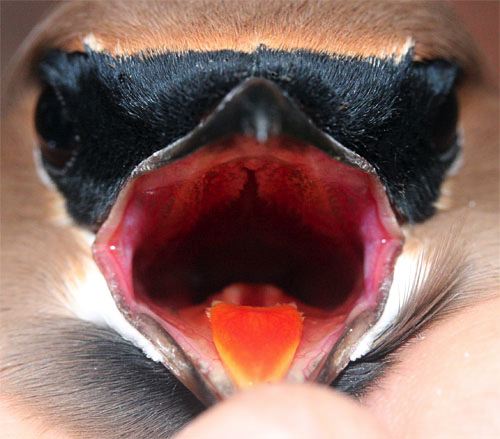 All text & photos © Hilton Pond Center The width of the waxwing's oral opening nearly rivals that of "goatsuckers"--aerial feeders such as Whip-poor-wills and Common Nighthawks. And, surprisingly, the bill lining and throat are bright pink and the tongue practically glows orange. Many kinds of birds have much paler gapes, with vivid mouths occurring primarily among nestlings in which the color serves as a "target area" that stimulates parent birds to respond to begging. Perhaps with age the mouths of these relatively young first-year waxwings will darken--or go pale. Two interesting aspects of the Cedar Waxwing's oral anatomy show in the photo above: Short, hard spines in the roof of the mouth, and rear-facing barbs at the visible base of the tongue. In many birds tongue barbs and mouth spines are much larger and more sharply pointed, functioning to keep not-quite-dead insects or other live prey from crawling back up the bird's gullet. Since waxwings eat lots of wild fruits, we speculate tongue barbs are needed somewhat less and that the short, hard spines inside the upper bill help crush berries into pulp that is more easily ingested. That said, it's important to remember Cedar Waxwings DO consume lots of insects spring through autumn--especially beetles, ants, flies, cicadas, and caterpillars that provide fats and proteins for both adults and nestlings. As evidence they are also insectivores, in summer waxwings often act like flycatchers, hawking insects from the air--especially over water. Waxwings won't pass up a succulent berry during the breeding season, but during cold weather months they rely almost exclusively on wild fruit--from withered crabapples and Muscadine grapes to the Eastern Red Cedar berries that give Cedar Waxwings the other half of their name. They're also known to lap up tree sap when it's available.
So, with all the above information in mind, why is it we believe Cedar Waxwings are so "elegant?" Give them a second look, and you'll surely agree. After all, waxwings have a soft, regal crest (above) that sometimes drifts jauntily to the side like a beret; there's a jet black mask lined with bright white; their subtly colored plumage blends from tan to brown to gray to yellow and seems to lie smoother and sleeker than that of other birds; sometimes they bear that waxy red spot on their wings; and the squarish tail is tipped in bright yellow or, these days, an occasional dull orange. Surely this is an outfit any fashion-savvy bird would be pleased to wear to an avian formal affair. We admit it's one of those HVJs--"Human Value Judgments"--but we really do think Cedar Waxwings are the "most elegant" birds in North America. All text & photos © Hilton Pond Center POSTSCRIPT: Late on the afternoon of 17 November we put the finishing touches on the Cedar Waxwing photo essay above and went out to close our mist nets. We had been running only the four nets closest to the old farmhouse at Hilton Pond Center and had nothing to show for two days of work except recaptures of previously banded birds. When we came to the final net, however, what did we find but--you guessed it--five more Cedar Waxwings, one of which required us to add this postscript.
All text & photos © Hilton Pond Center The first four were immatures just like the 31 birds caught on 9 November, but the last was an adult male (above) that finally bore those bright red secondary tips missing from all our previous waxwings. This individual dictated we take a few photos and add a little more text to our current installment.
All text & photos © Hilton Pond Center The photo above reveals the waxwing's red spots do appear waxy, but in reality they are simply very smooth extensions of the tip of the feather vane. The red tip hiding on the right side of the image above is at the end of a secondary wing feather just coming in. (Most older waxwings complete a molt on their wintering grounds; this bird was about halfway finished molting its secondaries.)
All text & photos © Hilton Pond Center As a follow-up to our ageing techniques for the 31 Cedar Waxwings netted last week, we examined the eye of the newly captured adult male and, as anticipated, his iris (above) was uniform in color and with much greater clarity than what we found in immature birds. However, we also looked at his mouth color and were surprised,to find the bill lining still bright pink and the tongue orange, thus suggesting mouth color is not very useful in ageing our "elegant" Cedar Waxwings at Hilton Pond Center. All text & photos © Hilton Pond Center
Comments or questions about this week's installment?
Thanks to the following fine folks for recent gifts in support of Hilton Pond Center for Piedmont Natural History and/or Operation RubyThroat: The Hummingbird Project. Your tax-deductible contributions allow us to continue writing, photographing, and sharing "This Week at Hilton Pond." (Please see Support if you'd like to make a gift of your own. You can also contribute by ordering an Operation RubyThroat T-shirt.)
"This Week at Hilton Pond" is written & photographed You may wish to consult our Index of all nature topics covered since February 2000. You can also use our on-line Hilton Pond Search Engine at the bottom of this page. For a free, non-fattening, on-line subscription to |
|
Make direct donations on-line via
Network for Good: |
|
|
Use your PayPal account
to make direct donations: |
|
|
If you like to shop on-line, you please become a member of iGive, through which more than 750 on-line stores from Barnes & Noble to Lands' End will donate a percentage of your purchase price in support of Hilton Pond Center and Operation RubyThroat. For every new member who signs up and makes an on-line purchase iGive will donate an ADDITIONAL $5 to the Center. Please sign up by going to the iGive Web site; more than 200 members have signed up to help. It's a painless, important way for YOU to support our on-going work in conservation, education, and research. |
|
|
SPECIES BANDED THIS WEEK: * = New species for 2009 WEEKLY BANDING TOTAL 2 species 6 individuals 2009 BANDING TOTAL 62 species (28-year avg. = 68.9) 1,694 individuals (avg. = 1,913.4) 28-YEAR BANDING GRAND TOTAL (since 28 June 1982, during which time 170 species have been observed on or over the property) 124 species 53,576 individuals
|
OTHER NATURE NOTES OF INTEREST --Post-Hurricane Ida weather stalled over the Carolinas for several days this week, leaving Hilton Pond Center with 3.25" of precipitation in the trusty old rain gauge. The pond rose a foot but we couldn't run mist nets in the rain, so weather and a weekend business trip to the coast allowed 16-17 Nov as our only banding days. Results are at left. --A rather ancient male Eastern Towhee netted on 11 Nov was banded at the Center as a recent fledgling in Sep 2003. Previous recaptures occurred in 2004 on 1 Jan, 11 Apr, and 13 May, after which he was not caught again until 26 May 2007. Additional recaptures were in 2008 on 26 Apr, 3 Jun, and 8 Aug. It appears this experienced old towhee is a permanent resident at Hilton Pond, and that he's very good at learning to avoid mist nets and traps. (Two of his recaptures in 2004 when he was still rather young were in two different styles of traps; all other recaptures were in mist nets.) All text & photos © Hilton Pond Center
NOW is the time to report your RTHU fall departure dates from the U.S. & Canada, and fall arrival dates for Mexico & Central America. Please participate.
|
|
(Back to Preceding Week; on to Next Week) Up to Top of Page Back to This Week at Hilton Pond Center Current Weather Conditions at Hilton Pond Center |
 You can also post questions for The Piedmont Naturalist |
Join the |
Search Engine for |
|
|
Expedia Flights

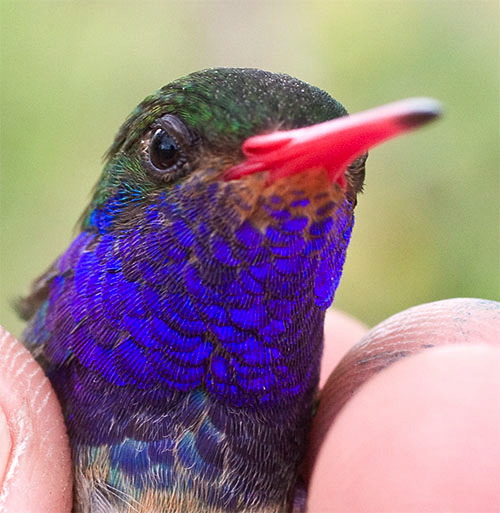
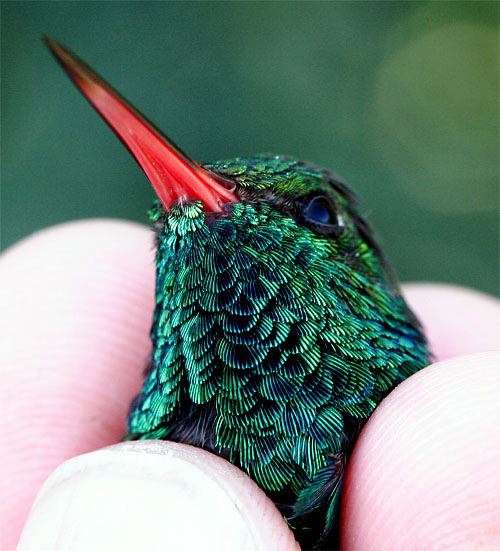
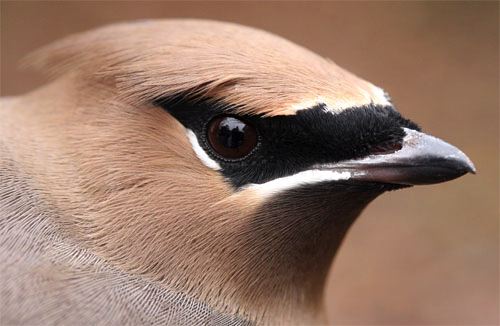
 The pool becomes a chaotic, noisy scene (right) with so much chirping and flapping the rocks rimming the water garden are soon covered with water. After bathing, the birds ascend to a nearby tree, fluff up and flap a little more to remove excess moisture, and--as if on cue--zoom off to some unknown destination in a tight but erratic flock. (HINT: To attract Cedar Waxwings, install a garden pool with a recirculating waterfall that makes lots of gurgling noises.) After witnessing the bathing frenzy, we always think: "Gee, wouldn't it be great if a few of those waxwings got caught in our mist nets so we could band and photograph and examine them more closely." Last week, our wish was granted . . . at a somewhat higher level than anticipated.
The pool becomes a chaotic, noisy scene (right) with so much chirping and flapping the rocks rimming the water garden are soon covered with water. After bathing, the birds ascend to a nearby tree, fluff up and flap a little more to remove excess moisture, and--as if on cue--zoom off to some unknown destination in a tight but erratic flock. (HINT: To attract Cedar Waxwings, install a garden pool with a recirculating waterfall that makes lots of gurgling noises.) After witnessing the bathing frenzy, we always think: "Gee, wouldn't it be great if a few of those waxwings got caught in our mist nets so we could band and photograph and examine them more closely." Last week, our wish was granted . . . at a somewhat higher level than anticipated.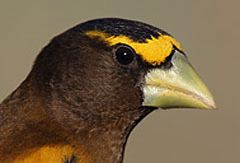 During our 30-plus years of bird banding, only once had we caught so many birds of a single species all at one time, that being back in Minnesota grad school days when we snared a flock of two dozen big-billed Evening Grosbeaks in 20-degree weather. Because Grosbeaks (male, above left) seem to go bonkers when captured, individuals in that flock were shrieking and snapping and twisting about as we used our stiff, numb, frozen fingers to extricate them from their predicament. The name "grosbeak" is well earned, of course, so these aggressive black and yellow birds bit us numerous times, drawing blood and convincing us we would never again run mist nets when the temperature drops below freezing. And we never have--except on cold, dark nights while trying to catch midwinter owls.
During our 30-plus years of bird banding, only once had we caught so many birds of a single species all at one time, that being back in Minnesota grad school days when we snared a flock of two dozen big-billed Evening Grosbeaks in 20-degree weather. Because Grosbeaks (male, above left) seem to go bonkers when captured, individuals in that flock were shrieking and snapping and twisting about as we used our stiff, numb, frozen fingers to extricate them from their predicament. The name "grosbeak" is well earned, of course, so these aggressive black and yellow birds bit us numerous times, drawing blood and convincing us we would never again run mist nets when the temperature drops below freezing. And we never have--except on cold, dark nights while trying to catch midwinter owls.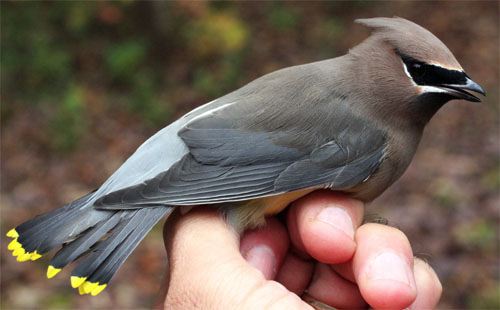
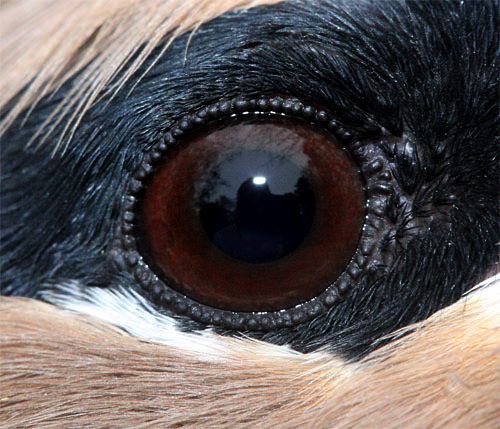
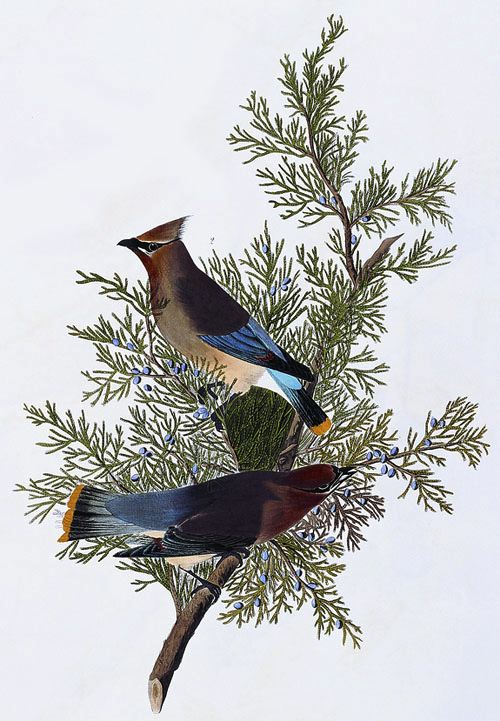
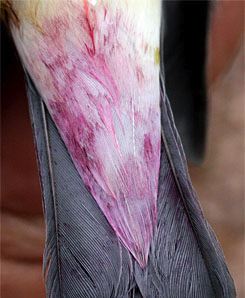 As with other birds, waxwings are unable to produce yellow on their own; the tail color comes from plant pigments consumed by the birds and laid down by feather follicles as plumage comes in. Waxwings are highly frugivorous--i.e, fruit-eating--so carotene pigment needed to produce yellow plumage comes from berries, or from other plant parts, including flower petals. (Anyone who doubts the berry-eating habits of Cedar Waxwings need only look at the photo above right of undertail coverts of one that soiled itself temporarily while in a mist net. At this time of year, we're guessing the purple is from the berries of Black Tupelo, Nyssa sylvatica, but any number of ripe wild fruits could be the source.)
As with other birds, waxwings are unable to produce yellow on their own; the tail color comes from plant pigments consumed by the birds and laid down by feather follicles as plumage comes in. Waxwings are highly frugivorous--i.e, fruit-eating--so carotene pigment needed to produce yellow plumage comes from berries, or from other plant parts, including flower petals. (Anyone who doubts the berry-eating habits of Cedar Waxwings need only look at the photo above right of undertail coverts of one that soiled itself temporarily while in a mist net. At this time of year, we're guessing the purple is from the berries of Black Tupelo, Nyssa sylvatica, but any number of ripe wild fruits could be the source.)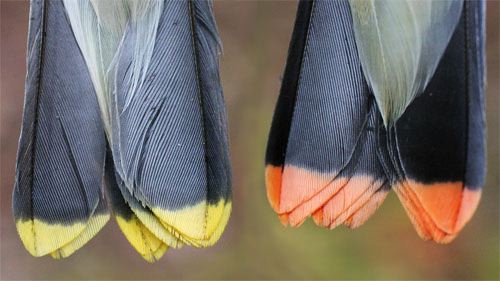
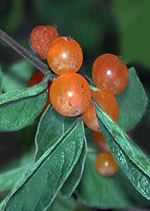 and as far as anyone knows those waxwings always had yellow tail tips (above left). In recent decades, however, birders have noticed increasing numbers of Cedar Waxwings with rectrices tipped in some shade of orange or salmon (above right). We don't think waxwing genes that instruct feather follicles to lay down yellow pigment have mutated, but waxwing diet HAS changed--primarily because humans have imported and propagated berry-bearing flora such as Morrow's Honeysuckle, Lonicera morrowii, or possibly Tartarian Honeysuckle, L. tatarica (above right) and Pyracantha spp.
and as far as anyone knows those waxwings always had yellow tail tips (above left). In recent decades, however, birders have noticed increasing numbers of Cedar Waxwings with rectrices tipped in some shade of orange or salmon (above right). We don't think waxwing genes that instruct feather follicles to lay down yellow pigment have mutated, but waxwing diet HAS changed--primarily because humans have imported and propagated berry-bearing flora such as Morrow's Honeysuckle, Lonicera morrowii, or possibly Tartarian Honeysuckle, L. tatarica (above right) and Pyracantha spp. 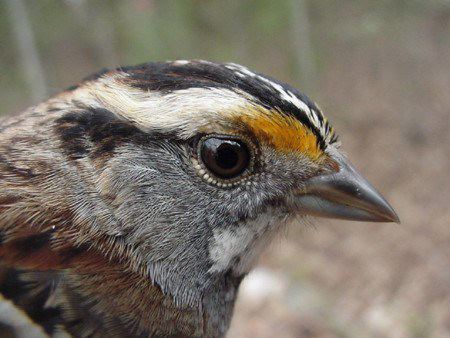 Apparently, rhodoxanthin pigment from these ornamental plants is different enough that at least some waxwings dining on non-native fruits end up with tails discolored by this purplish-red pigment. (We surmise red from rhodoxanthin blends with carotene's yellow to produce orange tail tips.) Curiously, we've also banded a few White-throated Sparrows (above left) whose lores were orange, not yellow--possibly an indicator they, too, have been dining on berries from imported honeysuckle.
Apparently, rhodoxanthin pigment from these ornamental plants is different enough that at least some waxwings dining on non-native fruits end up with tails discolored by this purplish-red pigment. (We surmise red from rhodoxanthin blends with carotene's yellow to produce orange tail tips.) Curiously, we've also banded a few White-throated Sparrows (above left) whose lores were orange, not yellow--possibly an indicator they, too, have been dining on berries from imported honeysuckle.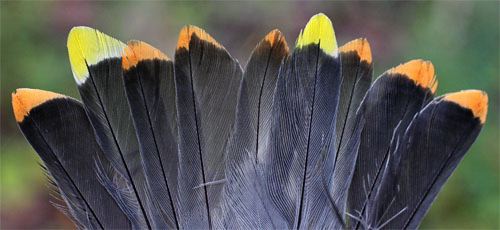
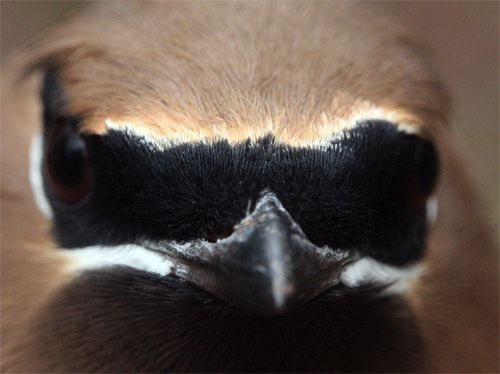
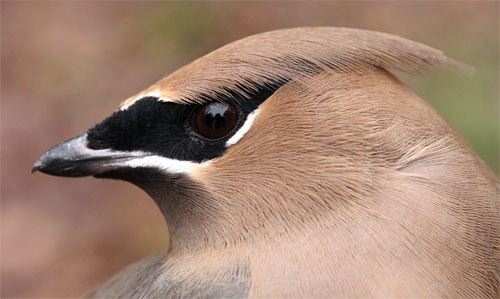
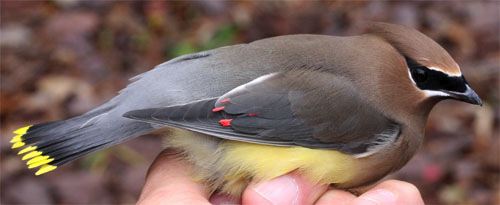
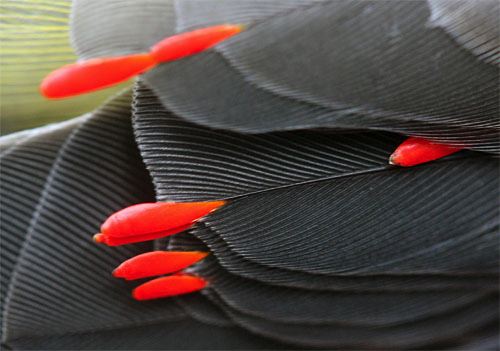
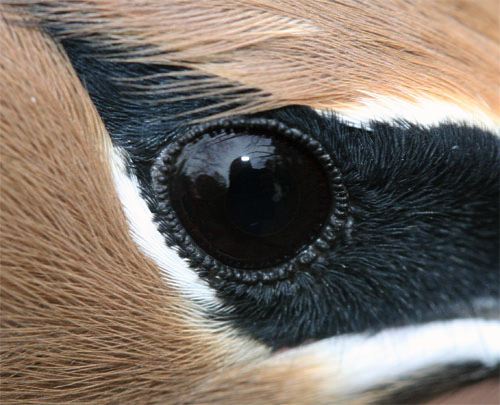



 Oct 15 to Mar 15:
Oct 15 to Mar 15: